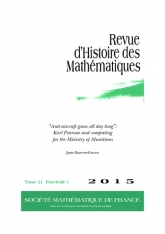“Anti-aircraft guns all day long” : Karl Pearson et l'informatique au Ministère des munition
“Anti-aircraft guns all day long” : Karl Pearson and computing for the Ministry of Munitions

- Consulter un extrait
- Année : 2015
- Fascicule : 1
- Tome : 21
- Format : Électronique
- Langue de l'ouvrage :
Anglais - Class. Math. : 01A60.
- Pages : 111-150
- DOI : 10.24033/rhm.186
Au mois de décembre 2016, Karl Pearson offrit au Ministère des munitions les services de son personnel du Drapers' Biometric Laboratory et du Galton Eugenics Laboratory, à University College London. L'offre fut très vite acceptée par le chef de la Section expérimentale antiaérienne, A.V. Hill, pressé de libérer sa propre équipe du travail de calcul. De janvier 1917 à mars 1918, Pearson travailla infatigablement au calcul souvent ingrat des tableaux balistiques, des tables de tir à angle élevé, et des étalonnages de fusée. Il apporta aussi des contributions significatives à la théorie mathématique sur laquelle les tables se fondaient. L'équipe de Pearson incluait des mathématiciens, des calculateurs et des dessinateurs. Les femmes en formaient un contingent important, en particulier parce que les demandes de plus en plus grandes de la conscription rendaient les hommes vulnérables aux sergents-recruteurs. Les obstacles ne manquèrent pas — Pearson n'appréciant pas que les calculs de son équipe soient remis en question par les mathématiciens produisant les données — et Hill eut parfois du mal à maintenir la paix.
Karl Pearson, première guerre mondiale, balistique extérieure, artillerie anti-aérienne.
